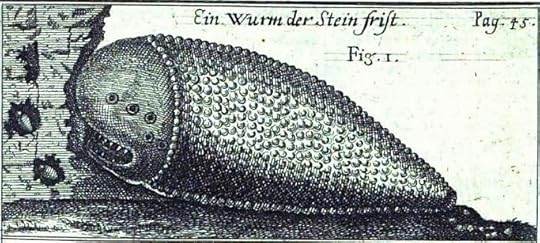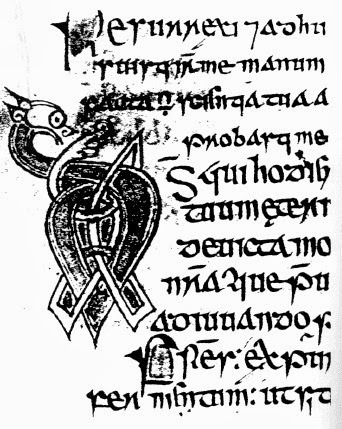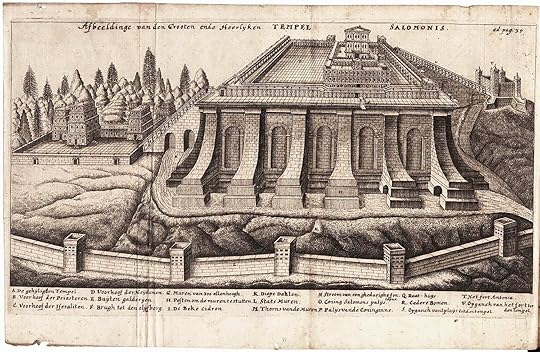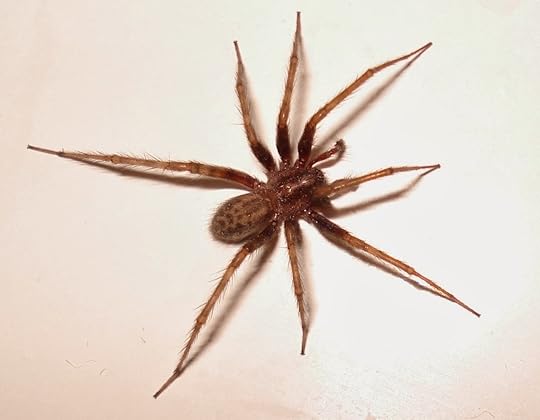THE SHAMIR AND THE STONE WORM
 st1\:*{behavior:url(#ieooui) } The first of two engravings of a medieval and highly mysterious stone worm contained within a late 17th-Century book by Eberhard Werner Happel
st1\:*{behavior:url(#ieooui) } The first of two engravings of a medieval and highly mysterious stone worm contained within a late 17th-Century book by Eberhard Werner HappelThere are a number of mysterious and controversial biblical creatures with potential relevance to cryptozoology, of which the most famous examples are undoubtedly Leviathan and Behemoth (click here and here to see my ShukerNature investigations of them). Much less famous but no less remarkable than those two, however, is the small yet highly intriguing subject of this present ShukerNature post - the shamir.
Also spelled 'samir' or 'schamir', this is the Hebrew name given to a tiny worm-like creature referred to in certain Jewish holy books, including the Midrashim and the Talmud (particularly the Gemara – the component of the Talmud that consists of rabbinical analysis of, and commentary upon, an earlier work known as the Mishnah).
 The shamir as depicted within the Rosslyn Missal (an Irish manuscript dating from the late 13th or early 14th Century)
The shamir as depicted within the Rosslyn Missal (an Irish manuscript dating from the late 13th or early 14th Century)According to Jewish tradition contained within these and other sources, the shamir was created by God at twilight upon the Sixth Day of the Hexameron (the six days of Creation). Although it was only the size of a single grain of barley corn, the shamir was so incredibly powerful that merely its gaze was sufficient to cut through any material with ease, even through diamond itself, the hardest substance on Earth. Such a miraculous creature needed to be safeguarded, and so God entrusted the shamir to the hoopoe (or woodcock or moorhen, depending upon which version of the legend is consulted), commanding this bird to protect the shamir from all harm.
In order to contain this mighty if minuscule worm, the hoopoe placed it among a quantity of barley corns, then wrapped them all up together in a woollen cloth, which in turn was placed inside a box fashioned from lead – the only material strong enough to contain the shamir effectively but without disintegrating from the intensity of its laser-like gaze. So here, safely and comfortably ensconced within its leaden domicile, which was retained by the hoopoe in the Garden of Eden, it passed through all the ages that followed.
 Hand-coloured engraving of a hoopoe from 1840
Hand-coloured engraving of a hoopoe from 1840Only once did the shamir emerge – during the time of Aaron and Moses, when God commanded the hoopoe to lend this worm to Him for the etching of the names of the 12 tribes of Israel upon the precious stones on 12 special priestly breastplates (the Hoshen), one breastplate for each of the tribes and each breastplate composed of a different stone. The task was a very difficult one, but the shamir accomplished it so expertly that not a single atom of precious stone was lost or destroyed.
After this, the shamir was placed back inside its lead casket, entrusted once more to the hoopoe's care, and there it remained, in undisturbed obscurity – until the time of King Solomon the Wise. Solomon wished to erect a glorious temple, but he was very mindful of God's instructions, laid down long ago to Moses, that no place of worship, not even an altar (let alone a temple), should be constructed using any tool made from iron - because iron was a substance of war, and that if anything related to war should ever touch a place of worship, it would be instantly and irrevocably defiled. But if Solomon could not use iron tools, how could the stones needed for constructing his temple be hewn?
 An etching of the famous and much-exhibited model of Solomon's Temple created during the 1600s by Rabbi Jacob Jehudah Leon, which measured 80 ft in circumference and 13 ft high, and was based upon information contained within the Bible's Book of Kings, Book of Samuel, and Book of Chronicles
An etching of the famous and much-exhibited model of Solomon's Temple created during the 1600s by Rabbi Jacob Jehudah Leon, which measured 80 ft in circumference and 13 ft high, and was based upon information contained within the Bible's Book of Kings, Book of Samuel, and Book of ChroniclesIn an attempt to solve this riddle, Solomon enquired far and wide, and eventually he learnt about the incredible stone-searing shamir. Determined to utilise its extraordinary power, Solomon dispatched a servant to seek out this wonderful creature and bring it back to him. After a long search, the servant succeeded, and Solomon duly employed the shamir to cut the rocks required for building his celebrated temple – the First Temple in Jerusalem. But that is where the story ends abruptly – because after this magnificent edifice was completed, the shamir allegedly lost its power, then vanished, and has never been heard of again…or has it?
I had always assumed that the shamir was entirely mythical – until 28 November 2013, that is, when Facebook friend Robert Schneck very kindly brought to my attention an astonishing but hitherto exceedingly obscure mystery beast that seemed at least on first sight to be a veritable shamir of the Middle Ages. Robert revealed to me two engravings of bizarre-looking beasts known as vermes lapidum or stone worms, and which had appeared in a hefty German tome authored by Eberhard Werner Happel and entitled Relationes Curiosae, oder Denckwürdigkeiten der Welt, which was originally published in five volumes between 1683 and 1691.
 Two engravings of alleged stone worms from Happel's Relationes Curiosae, oder Denckwürdigkeiten der Welt
Two engravings of alleged stone worms from Happel's Relationes Curiosae, oder Denckwürdigkeiten der WeltAccording to Happel, the stone worms had originally been brought to public attention by a 17th-Century monk called de la Voye, from a Normandy monastery, who in 1666 had written a letter to a Lord Auzout describing his remarkable discovery. One day, de la Voye had found some of these very small, decidedly odd-looking creatures moving about incessantly inside some holes of their own making in an old wall, much of whose rocky composition had allegedly been eaten away and converted into dust by the devouring nature of the worms. When he pulled out some of them and examined them under a magnifying glass, the monk observed that they were each the size of a single barley corn (the very same description, intriguingly, as used in the Jewish holy books for the shamir) and enclosed in a grey shell, as depicted in the first (labelled Fig. 1) of the two engravings presented above. As quoted by Happel in his book, the monk continued his account of the stone worms in his letter to Lord Azout as follows:
"…on the tip [of the worm's body] there is a hole, through which the excrements can be excreted. On the other end there is a larger hole, trough which the head can be protruded.
They are entirely black, the body shows various segments, near the head there are three legs, each has two joints, not dissimilar to these of a flea.
When they move their body is suspended in air, the mouth but is still oriented to the rock. The head is bulky, a bit smooth, similar in shape and colour to the shell of a snail...also the mouth is similar large, with four kinds of teeth disposed in cross like manner."
The second engraving (Fig. 2) presumably shows the stone worm in a more advanced state of development than in Fig. 1, as it is now equipped with three pairs of legs. However, both forms seem only to possess small, primitive, laterally-sited ocellus-like eyes (round and black, according to de la Voye), rather than large, compound eyes, thereby indicating that if the stone worm is an insect, as seems at least remotely possible, it is a larval form rather than an adult (larval insects do not possess compound eyes, only ocelli).
 Tegenaria domestica
, a common species of funnel-weaving spider
Tegenaria domestica
, a common species of funnel-weaving spiderConversely, some authors have sought to discount the stone worms as (very) fanciful representations of funnel-weaving spiders, three pairs of legs rather than four notwithstanding and the stone worms' reputed rock-devouring proclivities discounted as apocryphal. Perhaps the presence of multiple ocelli, a characteristic of many spiders (which never possess compound eyes like most adult insects do), influenced their choice of an arachnid identity for these creatures, as there seems little else that would have done so? Certainly, the heavily segmented abdomen of the creature in the second engraving, and the seemingly limbless, shelled form of the creature in the first one, present major problems in reconciling them with any spider.
To be honest, however, the creatures depicted in these two engravings are so bizarre that it is impossible to identify them confidently with any known animal form. If they were indeed real, and not a hoax perpetrated by de la Voye, we can only assume that these engravings are exceedingly fanciful representations, so much so that the worms' true morphology has been enshrouded in exaggeration or error.
As for their stone-devouring diet, this too is baffling in the extreme. Perhaps de la Joye saw these creatures amid the wall's crumbling masonry and wrongly presumed that they were responsible? Who can say? All that can be stated is that except for a couple of brief mentions in some early 18th-Century dictionaries of natural science, the stone worm rapidly faded into total scientific oblivion shortly after Happel's book was published.
 Happel's Relationes Curiosae, 1683
Happel's Relationes Curiosae, 1683Could it be that, as a monk, de la Voye was well-read across a wide spectrum of religious tracts, was therefore familiar with the mythical shamir from Jewish holy books, and had mistakenly thought that the creatures that he had discovered were similar? In reality, however, even his stone worms' ostensible comparability to the shamir does not stand up to close scrutiny. For whereas the latter beast disintegrated and annihilated rocks using its formidable, basiliskian gaze, the stone worm actually devoured rocks and stones, at least according to de la Voye's testimony.
Almost 350 years have passed since de la Voye wrote his intriguing letter documenting the stone worms, but its subjects remain as mystifying and as unsatisfactorily 'explained' today as they were then. Unless the entire episode of their discovery was indeed a hoax and a nonsense, the stone worms must have been something – but what?
 The second of two engravings of a medieval and highly mysterious stone worm contained within a late 17th-Century book by Eberhard Werner Happel
The second of two engravings of a medieval and highly mysterious stone worm contained within a late 17th-Century book by Eberhard Werner Happel
Published on February 24, 2014 06:25
No comments have been added yet.
Karl Shuker's Blog
- Karl Shuker's profile
- 45 followers
Karl Shuker isn't a Goodreads Author
(yet),
but they
do have a blog,
so here are some recent posts imported from
their feed.



